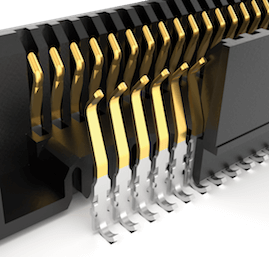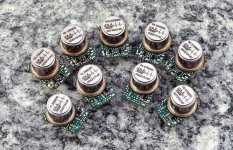I have no experience with WaveIO but if there is an issue with it you could have just used another USB-I2S board. FifoPi is in essence bit perfect only until first buffer over/underrun.
FIFO_Pi provides galvanic isolation, an option for better clocks, better clock power supplies, clock buffering, and I2S reclocking. Its more than a FIFO buffer. If you use an async USB solution with everything FIFO_Pi does, except without the FIFO buffering part, then your USB can sound just as good as FIFO_Pi, and no problems with underruns/overruns.
What exactly are you referring to in this post? I'm wondering because I'm always looking for a way to improve the sound. What are the pin header connections you are referring to? Also, do you feel that all power connections should be soldered? I'm using a LinearPi to UcConditioner to FifoPiQ7 and am wondering if everything from the transformer to the FifoPiQ7 should be soldered, if it would be worth it or not.Beyond that, tin pin header interconnects can introduce timing jitter. All critical pin header connections should be gold plated or gold flashed.
Not necessarily. They should be tight, meaning you shouldn't be able the pull the wire out of a crimp or out of an screw-down connector. If you pull hard enough, the wire should break first before it pulls out of the connector.do you feel that all power connections should be soldered?
Don't I know it. My last two builds stayed in a perpetual state of evolvement it seemed for months. I changed a few things as a result of my implementation decisions - or indecision. 🙂 Ian's products allow for myriad of combinations depending on the path you choose for your final project.Thanks, it’s not easy to have a clean looking build when new components from Ian is released all the time, but it sounds very good compared to many commercial dacs.
Beyond that, tin pin header interconnects can introduce timing jitter. All critical pin header connections should be gold plated or gold flashed.
I wasn't aware tin versus gold was a thing. I only use pin header interconnects for ir receiver, so not important. But I'm wondering do you recommend gold for GPIO pins? I try to only use Samtec pins, but I went with the tin option to keep it simple. Should I select gold for my next StationPi build? I selected -T. I'm guessing -G would be optimal?
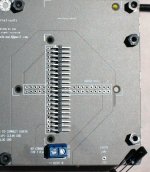
Building a Solid Connection: Tin vs. Gold
August 15, 2016 By Dylan Lang
Contact materials have always been a subject of debate in the electronics industry. Innovation and industrialization have both pioneered and degraded universal standards of contact designs. Although you could sit around all day to argue which conductor/metal is the better choice, any discussion of contacts must address the plating material selected for the application, primarily gold vs. tin. Demonstrating the pros and cons of both materials will allow consumers to determine what befits their budgets and needs.
https://blog.samtec.com/post/building-solid-connection-tin-vs-gold/
What Plating Option Is Best For My Connector?
October 19, 2017 By Danny Boesing
Choosing the right plating is critical to the success of a connector system. Plating affects the connector’s performance, life cycle, quality, and cost.
https://blog.samtec.com/post/what-plating-option-is-best-for-my-connector/
Not necessarily. They should be tight, meaning you shouldn't be able the pull the wire out of a crimp or out of an screw-down connector. If you pull hard enough, the wire should break first before it pulls out of the connector.
Thank you for this. I also started second guessing if soldering the power terminals was optimal. But IMO, as long as both washer sides are flat to the wire it's all good and a bag of chips. Plus I use a torque screwdriver, so it's firmly tight.
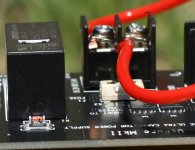
Last edited:
Since my latest software update for my low latency realtime kernel now defaults to overvoltage settings, I decided to attach my quiet fan to the bottom of the StationPi. I padded with gels before tightening with zip ties to keep it extra firm, dampen vibration and max silent/quiet.
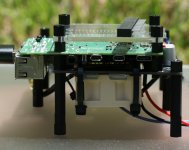
I also received more Eatons, so 3.3V is next.
Preliminary, my off of Mains triple stack of Mini LiFePO4 6.6V -> LinearPi 5V -> UcConditioner 5V with Raspberry Pi overvoltage / overclocking, I get about 4.5 hours which is more than I expected before it exits "Pure Mode". I have not added any HATs yet.
I also procured a Raspberry Pi 8GB. I didn't want to, but they Out of Stock in 5 minutes, so I just snatched it up.
With the whisper quiet fan, it hovers around 35 degrees C the entire 4.5 hours even with overclocking which gives a 40% RPi improvement.

I also received more Eatons, so 3.3V is next.
Preliminary, my off of Mains triple stack of Mini LiFePO4 6.6V -> LinearPi 5V -> UcConditioner 5V with Raspberry Pi overvoltage / overclocking, I get about 4.5 hours which is more than I expected before it exits "Pure Mode". I have not added any HATs yet.
I also procured a Raspberry Pi 8GB. I didn't want to, but they Out of Stock in 5 minutes, so I just snatched it up.
With the whisper quiet fan, it hovers around 35 degrees C the entire 4.5 hours even with overclocking which gives a 40% RPi improvement.
Last edited:
Usually you want gold plating on the contact area, and some kind of solder tinning on the tail (if you're going to solder one end). The connectors on wires are similar: gold on the contact area, some kind of gold or tin on the wire end depending on how the connection to wire is being made. I usually crimp and solder wires into pin header housing inserts.Should I select gold for my next StationPi build?
The problem with exposed tin is that it corrodes in the atmosphere, especially in some environments. Very thin gold flash doesn't really stop corrosion.
Also, tin connections may work fine for several hours. The problem is corrosion combined with plastic deformation of metal contacts that are supposed to be elastic (springy). Sometimes they can be fine the night before, and by morning some of the springiness is gone, the connection loosens up, and jitter is the result. Gold is much more reliable in terms of maintaining a good connection as spring contact pressure relaxes some over time.
Last edited:
Usually you want gold plating on the contact area, and some kind of solder tinning on the tail (if you're going to solder one end). The connectors are wires are similar: gold on the contact area, some kind of gold or tin on the wire end depending on how the connection to wire is being made. I usually crimp and solder wires into pin header housing inserts.
The problem with exposed tin is that it corrodes in the atmosphere, especially in some environments. Very thin gold flash doesn't really stop corrosion.
Also, tin connections may work fine for several hours. The problem is corrosion combined with plastic deformation of metal contacts that are supposed to be elastic (springy). Sometimes they can be fine the night before, and by morning some of the springiness is gone, the connection loosens up, and jitter is the result. Gold is much more reliable in terms of maintaining a good connection as spring contact pressure relaxes some over time.
Yes, I solder the pins at the bottom of the StationPi. I'll take the gold + tail end tin into consideration for my future StationPi build as well as crimping the pins. So I'll try out the -L option, not -G. Definately not the flash option -F.
The present StationPi is already compromised with tin on the RPi side (soldered), so I have to half measure it this time.
I'm usually a full measure type, so knowing this I can plan to plug any holes when convenient for the long-term. Marathon, not sprint.
Cheers.
Last edited:
Not sure what you mean by that? Measure what and how? If you mean measure connector contact performance, it can a bit be tricky. Contacts may not be purely resistive. They may be nonlinear, time-invariant, and kind of like switch bounce. Current density across the effective contact area can make a difference in measurement result, and can also change the state of the connection properties....have to half measure it this time.
Point is to make sure you know what you are measuring is relevant (strongly correlated) with the end effect you actually care about. If not sure then you may have some work to do to find out.
There is Tiny VNA and a set of field probes. There is connecting a scope probe ground to the probe tip and using it as a loop antenna.
Thanks,I thought about it,Do you have an example please.
I just started my streamer, and placement and insulation is the next step.
If I am doing the following:
D. Simplified flagship RPi I2S/DSD network streamer transport
1. HdmiPi Pro (#17B) or TransportPi AES
2. FifoPi Q7 (#1D)
3. PurePi (#48A)
4. UcConditioner 3.3V (#26A)
5. MonitorPi (#49A)
Which rpi4b is recommended? Does the amount of memory matter? I am merely running a Roon endpoint.
D. Simplified flagship RPi I2S/DSD network streamer transport
1. HdmiPi Pro (#17B) or TransportPi AES
2. FifoPi Q7 (#1D)
3. PurePi (#48A)
4. UcConditioner 3.3V (#26A)
5. MonitorPi (#49A)
Which rpi4b is recommended? Does the amount of memory matter? I am merely running a Roon endpoint.
Not sure what you mean by that? Measure what and how? If you mean measure connector contact performance, it can a bit be tricky. Contacts may not be purely resistive. They may be nonlinear, time-invariant, and kind of like switch bounce. Current density across the effective contact area can make a difference in measurement result, and can also change the state of the connection properties.
Point is to make sure you know what you are measuring is relevant (strongly correlated) with the end effect you actually care about. If not sure then you may have some work to do to find out.
It's not literal. It parallels "Mickey Mouse Job" or "Half A$$ Job". It's like if you don't do it right the first time and it comes back to haunt you in the future (consequences). So if I'm using tin instead of gold, I can now consider that a Mickey Mouse Job, Half A$$ Job or a half measure.
a partial, halfhearted, or weak line of action
The term became pop culture with it being used in the Television Series, Breaking Bad, where one of the main characters decided to show mercy by not eliminating someone and it came back to haunt him later (wife killed by not eliminating that someone). They learned that lesson and in the future, there was no hesitation to eliminate other criminals or competition that would bite them in the butt later (consequences) if not eliminated. Full measure.
Mike Ehrmantraut makes an unannounced visit to Walt at home and reveals he also works for Gus, who would "take it as a problem" if Jesse would be jailed. Mike then tells Walt a story from his years as a cop, in which he laments over showing mercy to an alcoholic, continually abusive husband who subsequently killed his wife. Mike tells Walt he chose a "half measure" instead of killing the husband, and warns: "No more half measures."
https://en.wikipedia.org/wiki/Half_Measures
But in the context of DIY, it's more you try to do things right the first time (Full Measure) but sometimes you have to compromise (Half Measure). I don't like compromising, but in the case of tin I have to this time around.
Quotes:




It's like that OceanGate Titanic Sub. That was a half measure, not battle-tested solution. James Cameron would never allow that to go into production since he's a full measures type.
Last edited:
The things I mentioned are more for qualitative measurements as opposed to quantitative. Although with a VNA you can measure an RF frequency spectrum, for one example.Do you have an example...
So it depends on what test instruments you have, such as what kind of scope?
Regarding half measures, almost everything is something like that in reality. A system may fail completely, work perfectly, or be somewhere in between. If it doesn't fail completely, then its somewhere in between because there is no such thing as perfection in music reproduction. IMHO especially not for dacs and not for speakers.
Last edited:
IOW, if it's worth doing, it's worth doing right.It's not literal. It parallels "Mickey Mouse Job" or "Half A$$ Job". It's like if you don't do it right the first time and it comes back to haunt you in the future (consequences). So if I'm using tin instead of gold, I can now consider that a Mickey Mouse Job, Half A$$ Job or a half measure.
The term became pop culture with it being used in the Television Series, Breaking Bad, where one of the main characters decided to show mercy by not eliminating someone and it came back to haunt him later (wife killed by not eliminating that someone). They learned that lesson and in the future, there was no hesitation to eliminate other criminals or competition that would bite them in the butt later (consequences) if not eliminated. Full measure.
View attachment 1192199
View attachment 1192200
https://en.wikipedia.org/wiki/Half_Measures
But in the context of DIY, it's more you try to do things right the first time (Full Measure) but sometimes you have to compromise (Half Measure). I don't like compromising, but in the case of tin I have to this time around.
Quotes:
View attachment 1192204
View attachment 1192212
View attachment 1192213
View attachment 1192215
It's like that OceanGate Titanic Sub. That was a half measure, not battle-tested solution. James Cameron would never allow that to go into production since he's a full measures type.
Depends on how "right" is defined for a particular case. Also, there is no exact "right" for problems described as "wicked."...doing right.
https://en.wikipedia.org/wiki/Wicked_problem
Instead of the two above arguing over nothing and clogging up a thread… how about a question???!!!!!!!!….
If I am doing the following:
D. Simplified flagship RPi I2S/DSD network streamer transport
1. HdmiPi Pro (#17B) or TransportPi AES
2. FifoPi Q7 (#1D)
3. PurePi (#48A)
4. UcConditioner 3.3V (#26A)
5. MonitorPi (#49A)
Which rpi4b is recommended? Does the amount of memory matter? I am merely running a Roon endpoint.
If I am doing the following:
D. Simplified flagship RPi I2S/DSD network streamer transport
1. HdmiPi Pro (#17B) or TransportPi AES
2. FifoPi Q7 (#1D)
3. PurePi (#48A)
4. UcConditioner 3.3V (#26A)
5. MonitorPi (#49A)
Which rpi4b is recommended? Does the amount of memory matter? I am merely running a Roon endpoint.
- Home
- Source & Line
- Digital Line Level
- Asynchronous I2S FIFO project, an ultimate weapon to fight the jitter
